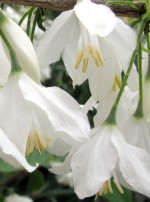 Two-winged silverbell is a deciduous small tree or large shrub native to southeastern US where it grows in moist woodland edges, streamside’s, and swales from South Carolina and Tennessee south to Florida and Texas. It is a member of the snowbell family, Styracaceae and has oval leaves with serrated margins. The leave are four to eight inches long and are dark green until turning yellow in fall. Pendulous clusters of three to six white bell-shaped flowers with two deeply lobed petals appear in spring. Each flower is less than 1.5 inches wide, and gives way to a brown seedpod with two papery wings in the fall. Plants are excellent for patios, woodland gardens, and shrub borders. The genus name Halesia honors Stephen Hales (1677-1761) an English clergyman and philantropist who made important contributions to botany, physiology, and pneumatic chemistry. The specific epithet is from the Greek words di meaning two and pteron meaning wings referring to the two-winged seedpod. The variety name magniflora comes from the Latin words magna meaning large, and flora meaning flower, referring to the larger size of the flower compared to the species.
Two-winged silverbell is a deciduous small tree or large shrub native to southeastern US where it grows in moist woodland edges, streamside’s, and swales from South Carolina and Tennessee south to Florida and Texas. It is a member of the snowbell family, Styracaceae and has oval leaves with serrated margins. The leave are four to eight inches long and are dark green until turning yellow in fall. Pendulous clusters of three to six white bell-shaped flowers with two deeply lobed petals appear in spring. Each flower is less than 1.5 inches wide, and gives way to a brown seedpod with two papery wings in the fall. Plants are excellent for patios, woodland gardens, and shrub borders. The genus name Halesia honors Stephen Hales (1677-1761) an English clergyman and philantropist who made important contributions to botany, physiology, and pneumatic chemistry. The specific epithet is from the Greek words di meaning two and pteron meaning wings referring to the two-winged seedpod. The variety name magniflora comes from the Latin words magna meaning large, and flora meaning flower, referring to the larger size of the flower compared to the species.
Type: Flowering deciduous tree
Outstanding Feature: Flowers
Form: Rounded crown
Growth Rate: Moderate
Bloom: Pendulous clusters of three to six white bell-shaped flowers 1.5 inches wide with two deeply lobed petals appear in spring.
Size: 20-40’ H x 20-30’ W
Light: Part shade
Soil: Average, moderately moist, well-drained, acidic
Hardiness: Zones 5-8
Care: Plants tend to become shrubs but can be pruned to be single stemmed and develop good structure.
Pests and Diseases: None of significance
Propagation: Seed, softwood cuttings in summer, root cuttings